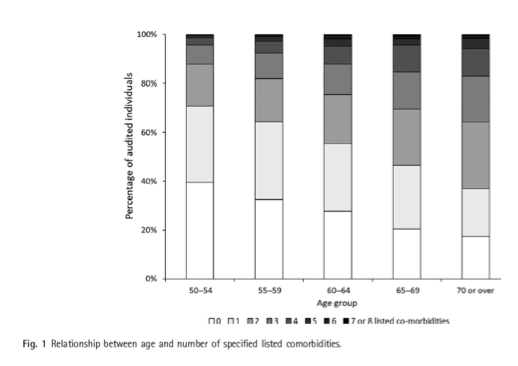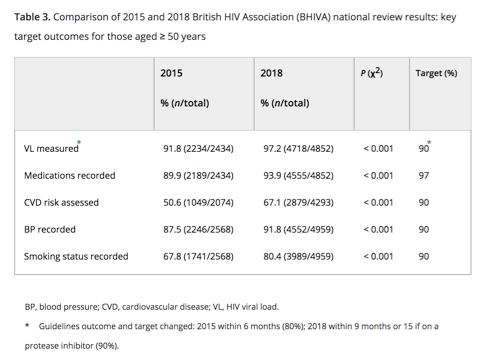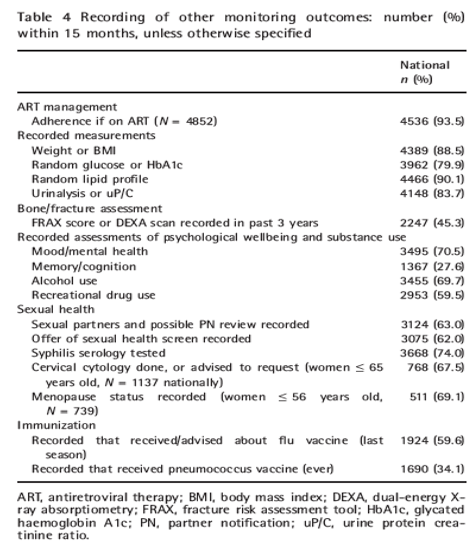| |
Gaps in Monitoring Older HIV+ in UK
|
| |
| |
Download the PDF here
see fig. 1 where about 15% >65 yrs.old had 6-7 or more comorbidities, 65% with 4 or more comorbidities over about 60 yrs old
In terms of our review outcomes, guideline targets were met nationally and by most individual sites for viral load monitoring and blood pressure measurement, but not for CVD risk assessment, smoking history or co‐medication documentation…..The World Health Organization (WHO) reports that deaths from CVD, diabetes and cancer in Africa are rising faster than anywhere else in the world 23. In sub‐Saharan Africa, HIV treatment is more readily available today than in previous decades, but it is not accompanied by services for these noncommunicable diseases 24. Some patients have access to the same treatments available in high‐income countries, but most do not. Therefore, prevention and early identification of these noncommunicable diseases is paramount if we are to avoid further premature deaths and long‐term morbidity…….Apart from key target outcomes specified in guidelines, monitoring of other outcomes was variable, with the lowest recorded rates being for bone/fracture risk assessment and asking about memory or cognition. Rates of monitoring of adherence and laboratory measurements were higher than those for wellbeing and lifestyle. It is of concern that only 71% of individuals had been asked about their mood or mental health, given that 50% of people living with HIV reported symptoms of depression and anxiety in the Stigma survey 5. In that survey, the greatest unmet need was for help dealing with isolation and loneliness, with one in five people living with HIV needing this help. This psychological challenge is likely to be accelerated in the ageing HIV‐infected population. However, the 2018 audit showed some improvement over BHIVA's 2017 national audit in this respect 13, as psychological wellbeing/mental health was documented or asked about for only 64% of individuals aged ≥ 50 years in the 2017 audit.
Recommendations and conclusions
Performance for outcomes assessed in this project varied widely between HIV services, but was generally better for HIV‐specific care and laboratory measurements than for CVD and bone/fracture risk assessment and recording of wellbeing and lifestyle. In the light of these findings, we recommend that clinics should have agreed methods locally to achieve standards specified in guidelines, including but not limited to the use of standardized clinical documentation proformas, where feasible, as prompts to these often forgotten questions and assessments. Clinic policies can recommend annual review consultations, with standard guidance to clinicians on investigations and assessments to be included in this in‐depth annual monitoring. Where electronic patient records and appointment systems are in use, these could be set up to provide automated reminders for annual review.
More generally, we have shown that clinician‐led national review of care standards, based on voluntary collection of retrospective case‐note data, is feasible. Feedback of individualized reports enables clinicians to see how their service's outcomes compare with national data, aiding motivation and prioritization of issues for local quality improvement. While any such approach should be adapted to local needs and circumstances, we believe that BHIVA's national review framework represents an example of good practice which could inform care quality improvement initiatives in other high‐, middle‐ and low‐income country settings.
--------------------
Monitoring of older HIV‐1‐positive adults by HIV clinics in the United Kingdom: a national quality improvement initiative
Abstract
Objectives
The aim of the study was to describe a UK‐wide process to assess adherence to guidelines for the routine investigation and monitoring of HIV‐positive adults aged ≥ 50 years and provide clinical services with individual feedback to support improvement in quality of care.
Methods
The British HIV Association (BHIVA) invited HIV clinical care sites to provide retrospective data from case notes of up to 40 adults aged ≥ 50 years with HIV‐1 infection attending the clinic for care during 2017 and/or 2018, using a structured dynamic online questionnaire.
Results
A total of 4959 questionnaires from 141 clinical services were returned. Regarding the key targets specified in the BHIVA monitoring guidelines, 97% of patients on antiretroviral therapy (ART) had had their viral load measured in the last 9 months, or 15 months if on a protease inhibitor, and 94% had had all medications recorded in the last 15 months.
Only 67% of patients on ART without cardiovascular disease (CVD) had had a 10‐year CVD risk calculated in the last 3 years. It was reported that 80% and 92% had had their smoking status documented in the last 2 years and blood pressure checked in the last 15 months, respectively. HIV services had communicated with the general practitioners of 90% of consenting individuals, but consulted electronic primary care records for only 10%.
Conclusions
Nationally, targets were met for viral load and blood pressure monitoring but not for CVD risk assessment, smoking status documentation and recording of comedication. There was variable performance in relation to other outcomes; adherence and laboratory measurements were carried out more regularly than lifestyle and wellbeing assessments.
Significant rates of comorbidity were recorded, with prevalences of specified listed conditions being: hypertension, 31%; hyperlipidaemia, 31%; depression with or without anxiety, 24%; renal impairment, 15%; CVD, 12%; obesity, 11%; type 2 diabetes, 11%; osteoporosis, 5%. These prevalences increased with age (Fig. 1), with 63% of individuals aged > 70 years having at least two of the listed comorbidities compared with 37% of those aged 50–54 years. Overall, 29% of individuals had at least one non‐HIV‐related condition of current clinical concern, comprising 334 (7%) with recent onset or diagnosis of the listed conditions; 941 (19%) with other conditions that were recently diagnosed or poorly controlled, including malignancies, chronic obstructive pulmonary disease (COPD), asthma and arthritis; and 160 (3%) with both.

Key target outcomes
Results for the key outcomes with targets specified in guidelines were as shown in Table 2. Nationally, 97% (4718 of 4852) individuals on ART had viral load measured within the past 9 months, or 15 months if they were taking a PI‐based regimen. Most sites performed well on this, meeting the 90% target [median 98%; interquartile range (IQR) 95–100%]. All medication had been recorded within the past 15 months for 94% (4555 of 4852) individuals on ART, slightly short of the target of 97%. The 90% target for blood pressure measurement was also met, with 92% (4552) of patients having had this recorded in the last 15 months. Smoking history and 10‐year CVD risk calculation targets were not met, being documented for only 80% (3989) and 67% (2879 of 4293 individuals on ART without CVD), respectively, within the specified time‐scales.
In comparison to the 2015 BHIVA national review of routine monitoring and investigations 12, there were improvements in all five key targets (Table 3), but there was still room for further improvement, especially in relation to CVD.

Recording of other monitoring
Results for other routine monitoring and lifestyle questions are shown in Table 4. Performance varied but was generally better for monitoring of adherence and laboratory measurements as compared with recording of wellbeing, lifestyle and fracture/bone assessment.

Medicines management
Polypharmacy increased with age, with the proportion of individuals taking at least four co‐prescribed non‐ART medications being 24%, 38% and 51% for those in their 50s, 60s and 70s, respectively. It was documented that 3423 (69%) individuals had been asked about nonprescribed OTC medication and 2710 (56%) about herbal or traditional remedies in the preceding 3 years.
Communication and shared care of comorbidities
Nationally, 4800 (96.8%) of the audited individuals were registered with a GP and 4431 (89%) had consented for the HIV service to communicate with their GP (site median 91%; IQR 84–95%). There had been communication from the HIV service to the GP within the previous 15 months for 3976 (90%) of consenting individuals but communication from the GP to the HIV service was recorded for only 328 (7%). The SCR had been consulted to check information about prescribed medications for 9% (413 of 4420) of audited individuals in England. In Scotland and Northern Ireland, an equivalent of the SCR had been checked for 29% (71 of 242) and 58% (15 of 26) individuals, respectively. Nearly half of participating sites (64 of 132) in England, Scotland or Northern Ireland did not report checking the SCR or an equivalent for any of their patients.
|
|
| |
| |
|
|
|